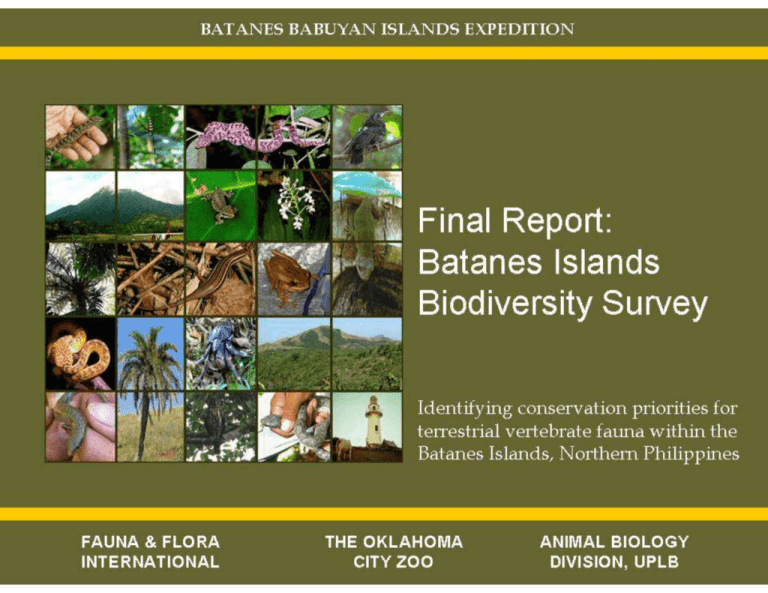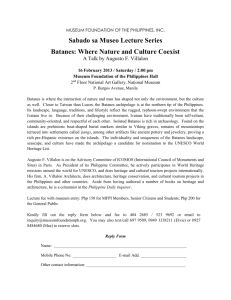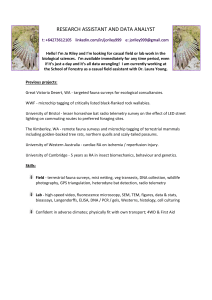Final Report Batanes Biodiversity Survey - quantum
advertisement

Final Report: Batanes Islands Biodiversity Survey Identifying conservation priorities for terrestrial vertebrate fauna within the Batanes Islands, Northern Philippines Juan Carlos T. Gonzalez, Leticia E. Afuang and Aurora V. Lacaste Animal Biology Division, Institute of Biological Sciences, College of Arts and Sciences, University of the Philippines Los Baños, College, Laguna 4031 Final Report on the Terrestrial Vertebrate Fauna Survey of the Batanes Islands, Northern Philippines 2 Summary Batanes Province harbors a moderately rich assemblage of terrestrial fauna due to its limited area and remote location in the Philippines, nearly equidistant to both Palearctic Taiwan and Wallacean Luzon. This isolation produced several endemic reptiles, birds and mammals allied to species from subtropical Taiwan-Ryukyus or tropical Philippines. This complementary mix of wildlife regarded Batanes as a distinct transitional biogeographic region (parallel with Babuyan Islands). Due to its unique geology, endemic fauna & flora, and indigenous Ivatan culture, the entire province was designated as a protected landscape & seascape and UNESCO heritage site. Past biological expeditions were concentrated around Mt. Iraya, Batan Island that revealed several endemic taxa. Despite being a priority protected area, little is known about the wildlife of other islands, particularly on smaller uninhabited islands. Recent studies in neighboring Calayan group led to the discovery of new species and records. Subsequent surveys conducted on four major islands of Batanes group in 2006 and 2007 by U.P. Los Baños similarly observed possible new taxa and records. Five reptiles, 10 birds and two mammals recorded are regionally restricted, echoing the significance of Batanes as a high priority for biodiversity conservation. Seven threatened and near-threatened species are known from Batanes including Platalea minor, Egretta eulophotes, Treron formosae, Otus elegans, Terpsiphone atrocaudata, Pteropus dasymallus and Trimeresurus mcgregori. Both regional endemics and threatened wildlife represent key species for conservation and serve as principal bio-indicators for management. Therefore, it is crucial that protection be centered on habitats inhabited by key species. Coastal areas and lowland forests surveyed were identified as critical habitats in Itbayat (Mt. Karoboban; Mt. Riposed; Mahayid cliffs), Batan (Mt. Iraya; Mt. Mahtarem); Sabtang (Malakdang; Vichinyi; Savidug-Chavayan; Nakanmuan) and Ivojos islands. Most sites represent remnant patches of old growth and secondary evergreen forests that harbor equally important endemic flora, but were in various degrees of encroachment. Some 30 resident species were consistently recorded across four islands forming its core fauna, which includes recent colonists and autochthonous island taxa. Several were analogous with Babuyan and Lanyu, showing geographical affinities and faunal similarities with Batanes. Moderate diversity exhibited by these isolated islands apparently relate to limited mobility and niche availability afforded to insular wildlife. Current results enriched the baseline information on insular vertebrate fauna of Batan, Itbayat, Sabtang and Ivojos islands, vital to community-based management and local conservation education. Although Batanes’ fauna was not as diverse as most Philippine islands, its inimitable wildlife represent an important contribution to the country’s natural heritage, and palpable link to north Asia. Final Report on the Terrestrial Vertebrate Fauna Survey of the Batanes Islands, Northern Philippines 3 Introduction Batanes (located 20o 30’ N; 121o 50’ E) is the most remote province in the Philippines, composed of a cluster of 10 isolated islands between the South China Sea and Pacific Ocean, covering a total of 23,347 hectares. The three largest islands of of Itbayat (9,000 ha), Batan (7,000 ha) and Sabtang (1,600 ha) harbors all five municipalities, fringed with smaller uninhabited islands such as Ivuhos, Diadekey and Dinem. The northernmost island of Y’Ami borders Lanyu (Botel Tobago) Island off Taiwan, thus sharing Palearctic elements from north Asia, some of which extend to the Babuyan islands. Despite its isolation, Batanes still shares distinctively Philippine endemics with Wallacean Luzon Island. This isolation produced several endemic reptiles, birds and mammals allied to species from subtropical Taiwan-Ryukyus or tropical Philippines. This complementary mix of wildlife regarded Batanes as a distinct transitional biogeographic region (parallel with Babuyan Islands). Final Report on the Terrestrial Vertebrate Fauna Survey of the Batanes Islands, Northern Philippines 4 Due to its unique geology, endemic fauna & flora, and indigenous Ivatan culture, the entire province was designated as a protected landscape & seascape and UNESCO heritage site. Past biological expeditions were mostly concentrated around Mt. Iraya in Batan Island that revealed several endemic taxa, similarly shared with Sabtang and Ivuhos. Despite being a priority protected area, little is still known about the wildlife of other islands, particularly on smaller uninhabited islands. Recent extensive studies in neighboring Calayan group led to the discovery of new species, new island records and even new country records. In retrospect, an extensive survey of terrestrial fauna in four major islands in the Batanes group is essential to better assess the status of biological diversity in this unique biogeographical region and priority protected area. Final Report on the Terrestrial Vertebrate Fauna Survey of the Batanes Islands, Northern Philippines 5 Mt. Karoboan, Itbayat Mt. Iraya, Batan Vichinyi, Sabtang Ivuhos Island Final Report on the Terrestrial Vertebrate Fauna Survey of the Batanes Islands, Northern Philippines 6 Methods Extensive surveys were conducted on four major islands of the Batanes group in April-May 2006 and May-June 2007 by a team of field biologists and students from U.P. Los Baños. Standard field methods for assessment (transect counts, trapping arrays and microhabitat sampling) of amphibians, reptiles, birds and mammals were deployed on lowland forest sites in Itbayat (Mt. Karoboban), Batan (Mt. Iraya); Sabtang (Vichinyi) and Ivojos islands. Subsequent surveys were also done on selected coastal areas and lowland forests in Itbayat (Mt. Riposed; Mahayid cliffs), Batan (Mt. Mahtarem) and Sabtang (Malakdang; Savidug-Chavayan; Nakanmuan). Most sites represent remnant patches of old growth and secondary evergreen forests that harbor equally important endemic flora, but most sites were in various degrees of human disturbance and agricultural encroachment. Clearance of inherently limited natural vegetation for subsistence farming and expanding cattle ranches were noted during the survey. Final Report on the Terrestrial Vertebrate Fauna Survey of the Batanes Islands, Northern Philippines 7 The project was able to provide invaluable field support to three undergraduate and graduate students. These included the following wildlife biology and zoology students from the University of the Philippines Los Baños: Kathy Lene S. Cielo, conducted a comparative survey of bat diversity the Batanes Islands (subsequently won 3rd place for the BPI Conservation Award 2008); Xy-za Chloe B. Reserva, conducted a survey of forest birds of the Batanes Islands; and A.V. Lacaste conducted a comparative Herpetofaunal survey in the Batanes Islands. The survey was also participated by field biologists from other FFI partner institutions, including ISLA Foundation (with Carmela Española) and Polillo Islands Biodiversity Conservation Foundation (with Enteng Yngente). Nearly all the live captures were release after measurements where taken, with only a few selected herpetological vouchers were collected thru an approved gratuitous permit from the DENR Region 2 and BPLS PAMB. Final Report on the Terrestrial Vertebrate Fauna Survey of the Batanes Islands, Northern Philippines 8 Results and Discussion The field team observed over 20 species of reptiles, more than 60 species of birds and some five species of mammals, including several possible new taxa (i.e., Eutropsis sp. and Lepidodactylus sp.) and new islandrecords (i.e., Gekko kikuchi, Lycodon bibonius, Pandion haliaeetus, Centropus australis). Five bengalensis reptiles (i.e., and Gekko Miniopterus porosus; Lepidodactylus balioburius; Draco jareckii; Lycodon alcalai and Trimeresurus mcgregori), 10 birds (i.e., Rallina eurizonoides alvarezi; Treron formosae filipina, Ptilinopus leclancheri longialis; Macropygia tenuirostris septentrionalis; Centropus viridis carpenteri; Otus elegans calayensis, Apus pacificus kanoi; Hypsipetes amaurotis batanensis; Terpsiphone atrocaudata periophthalmica and Zosterops meyeni batanis); and two mammals (i.e., Crocidura attenuata and Pteropus dasymallus) recorded are regionally restricted to the Batanes-Babuyan islands. Draco jareckii female Final Report on the Terrestrial Vertebrate Fauna Survey of the Batanes Islands, Northern Philippines 9 Presence of regional endemics echoes the significance of Batanes as a “very high” priority for biodiversity conservation and a protected landscape. Seven threatened and nearthreatened species are known from Batanes including Platalea minor, Egretta eulophotes, Treron formosae, Otus elegans, Terpsiphone atrocaudata, Pteropus dasymallus and Trimeresurus mcgregori. Current results enriched the baseline information on insular vertebrate fauna of Batan, Itbayat, Sabtang and Ivojos islands, vital to communitybased management and local conservation education. Comparison of faunal composition between the four islandsites indicate 50-60% similarity, with differences attributed to variable occurrence of migratory birds, waders and islandendemic herpetofauna. Notable species shared with Taiwan and Ryukyu Islands are Otus elegans, Microscelis amaurotis, Terpsiphone atrocaudata, Pteropus dasymallus and Crocidura attenuata. Otus elegans calayensis Final Report on the Terrestrial Vertebrate Fauna Survey of the Batanes Islands, Northern Philippines 10 The apparent scarcity of indigenous frogs and non-volant mammals on Itbayat and Ivuhos islands was reflective of the depauperate amphibian and mammalian fauna of the Batanes group. Some 30 resident species were consistently recorded across the four islands forming its core fauna, which includes recent colonists and autochthonous island taxa. Several were analogous with Babuyan and Lanyu islands, showing geographical affinities and faunal similarities with Batanes, harboring both typical Palearctic and Wallacean elements. Most important were several new island records added to the Batanes group, particularly for the poorly studied Ivojos, Sabtang and Itbayat islands. These include records for Eutropsis cumingi, E. bontocensis, Lycodon bibonius, Sphenomorphus abdictus, Gonyosoma oxycephalum, Gekko cf. kikuchi and Miniopterus australis, . There are also unknown species of Lepidodactylus and Rhinolophus. Pteropus dasymallus Final Report on the Terrestrial Vertebrate Fauna Survey of the Batanes Islands, Northern Philippines 11 Trimeresurus mcgregori Draco jareckii male Lepidodactylus balioburius Lycodon alcalai Gekko porosus Sphenomorphus abdictus Final Report on the Terrestrial Vertebrate Fauna Survey of the Batanes Islands, Northern Philippines 12 Zosterops meyeni Terpsiphone atrocaudata male Microscelis amaurotis Halcyon coromanda Macropygia tenuirostris Ptilinopus leclancheri male Final Report on the Terrestrial Vertebrate Fauna Survey of the Batanes Islands, Northern Philippines 13 Rhinolophus virgo Rhinolophus sp. Cynopterus brachyotis Pteropus dasymallus Miniopterus australis Crocidura attenuata Final Report on the Terrestrial Vertebrate Fauna Survey of the Batanes Islands, Northern Philippines 14 New Island Records for the Batanes Group Eutropsis cumingi Lepidodactylus sp. Gekko kikuchi Lycodon bibonius Final Report on the Terrestrial Vertebrate Fauna Survey of the Batanes Islands, Northern Philippines 15 Eutropsis bontocensis Sphenomorphus sp. Cuculus horsfieldi Centropus bengalensis Gonyosoma oxycephalum Ninox scutulata Final Report on the Terrestrial Vertebrate Fauna Survey of the Batanes Islands, Northern Philippines 16 Conclusion and Recommendations Batanes Province harbors a moderately rich terrestrial fauna due to its limited area and remote location, nearly equidistant to both Palearctic Taiwan and Wallacean Luzon. Due to its unique geology, endemic fauna & flora, and indigenous Ivatan culture, the province was designated as a protected landscape & seascape, world heritage site, and a distinct biogeographic region. Past biological expeditions were concentrated around Mt. Iraya, Batan Island that revealed several endemic taxa, but little is known about the wildlife of other islands. Surveys conducted on four major islands of Batanes in 2006 and 2007 by U.P. Los Baños recorded several possible new taxa and new island records. At least five reptiles, 10 birds, and two mammals recorded are regionally restricted, and several threatened species are known from Batanes. Trimeresurus mcgregori and survey team at Mt Iraya, Batan Final Report on the Terrestrial Vertebrate Fauna Survey of the Batanes Islands, Northern Philippines 17 These wildlife represent key species for conservation and serve as principal bio-indicators. It is crucial that protection be centered on habitats inhabited by key species, including coastal areas and lowland forests surveyed in Itbayat, Batan, Sabtang and Ivuhos islands. Most sites represent remnant patches of old growth and secondary evergreen forests in various degrees of encroachment. Species consistently recorded across islands form the core fauna, of which several were analogous with Babuyan and Lanyu islands. Moderate diversity exhibited by these isolated islands apparently relate to limited mobility and niche availability afforded to insular wildlife. Current results enriched the baseline information on vertebrate fauna of Batanes, vital to community-based management and local conservation education. Mahayid Caves, Itbayat and Diadekey Island, off Ivuhos Final Report on the Terrestrial Vertebrate Fauna Survey of the Batanes Islands, Northern Philippines 18 Both regional endemics and threatened wildlife represent key species for conservation and serve as principal bioindicators for monitoring and management. Therefore, it is crucial that protection be centered on habitats inhabited by these key species. Coastal areas and lowland forests surveyed were identified as critical habitats in Itbayat (Mt. Karoboban; Mt. Riposed; Mahayid cliffs), Batan (Mt. Iraya; Mt. Mahtarem); Sabtang (Malakdang; Vichinyi; SavidugChavayan; Nakanmuan) and Ivojos islands. Moderate diversity exhibited by the isolated islands of Batanes, Babuyan and Lanyu, apparently relate to limited mobility and niche availability afforded to insular wildlife, and constraints faced by northern and southern colonists. Mt. Iraya peak, Batan and Nakanmuan, Sabtang Final Report on the Terrestrial Vertebrate Fauna Survey of the Batanes Islands, Northern Philippines 19 Although Batanes’ fauna was not as diverse as most Philippine islands, its inimitable wildlife represent an important contribution to the country’s natural heritage, and palpable link to north Asia. Due to unavoidable logistical problems and limitations, other smaller uninhabited islands in the Batanes group were not visited, and therefore pose potential study sites. Further surveys are recommended for the smaller islands of Diadekey, Dinem, Siayan, Diturem, Mavudis and Y’Ami. Results of this current survey hopefully would support establishment of key priority areas or critical habitats within the protected area, and sustain future activities focused on local conservation education. Laticauda colubrina male Final Report on the Terrestrial Vertebrate Fauna Survey of the Batanes Islands, Northern Philippines 20 Bibliography Allen, D., C. Española, G. Broad, C. Oliveros and J.C. Gonzalez. 2006. New bird records for the Babuyan islands, including two first records for Philippines, Forktail 2:57-70. Brown, W.C. & Alcala, A.C. 1978. Philippine Lizards of the Family Gekkonidae. Monograph Series 1. Silliman University Press, 146 p. Brown, W.C. & Alcala, A.C. 1980. Philippine Lizards of the Family Scincidae. Monograph Series 2. Silliman University Press, 264 p. Dickinson, E.C., R.S. Kennedy and K.C. Parkes 1991. The birds of the Philippines, an annotated check-list. British Ornithologist's Union check-list No.12. Tring, U.K. 507 pp. Heaney, L.R., D.S. Balete, M.L. Dolar, A.C. Alcala, A.T.L. Dans, P.C. Gonzales, N.R. Ingle, M.V. Lepiten, W.L.R. Oliver, P.S. Ong, E.A. Rickart, B.R. Tabaranza Jr. and R.C.B. Utzurrum 1998. A Synopsis of the Mammalian Fauna of the Philippine Islands. FieldianaZoology Series No. 88, Field Museum of Natural History, Chicago. Mallari, N.A.D., B.R. Tabaranza Jr. and M.J. Crosby 2001. Key conservation sites in the Philippines: a Haribon Foundation and BirdLife International directory of important bird areas. With contributions from M. Lepiten-Tabao and G.A. Gee, in collaboration with Department of Environment and Natural Resources and Bookmark, Inc., Makati City. 486 pp. Ota, H. and C.H. Ross. 1994. Four new species of Lycodon from the Northern Philippines. Copeia 1994:159-174. Rosler, H., C.D. Siler, R.M. Brown, A.D. Demegillo & M. Gaulke. 2006. Gekko ernstkelleri sp. nov. – a new gekkonid lizard from Panay Island, Philippines, Salamandra 42(4):197-211 Shen, H.P. & C.F. Tsai 2002. Earthworm fauna of Lanyu Island (Botel Tobago), Taiwan Endemic Species Research Journal 4(2): 1-8. Wildlife Conservation Society of the Philippines. 1997. Philippine Red Data Book. WCSP and Bookmark, Inc. Final Report on the Terrestrial Vertebrate Fauna Survey of the Batanes Islands, Northern Philippines 21 Acknowledgements The Batanes Island Biodiversity Survey was generously supported by a grant from the Oklahoma City Zoo, Association of American Zoos & Aquaria, through Fauna & Flora International – Philippines Biodiversity Conservation Programme, in particular Brian Aucone and William Oliver, respectively. The authors are grateful for the participation of Kathy Lene Cielo, Xy-za Chloe Reserva, Vicente Yngente, Mark Vincent Yngente, Jimboy Zafe, Christmas de Guzman, Carmela Española, Pedro Abanador, Enrique de Guzman, Samuel Castillo, Henry Esperanza, Fausto Balanoba, Marcos Nobleza, Pol Villegas, Armand Gallardo and Fred Intervalo. The authors acknowledge the support of the following: Basco MENRO Francis Domingo, BPLS PASu George Reyes, Sabtang Mayor Juan Cabellero, Itbayat Mayor Reuel Ibañes, Governor Vicente Gato, Vice-Gov. Constante Castillejos, DepEd Sup. Emmelinta Belarmino, DepEd Batanes, Brgy Capt Gato, Baby Baroña, Cantor family, Gerlad Fajardo, Ereful family, Asa family, Abanador family, Cariaso family, Alavado family, Chemtrad, Asian Spirit Basco, Ivatan Lodge Inn, Click Internet Basco, PENRO Batanes, PAWB Dir. Mundita Lim, DENR Region 2, Animal Biology Division, Institute of Biological Sciences & Museum of Natural History, University of the Philippines Los Baños, PIBCFI (PESP-Chester Zoo), Philippine Society for Study of Nature, Babuyan Islands Expedition 2004 and people of Batanes Province. Final Report on the Terrestrial Vertebrate Fauna Survey of the Batanes Islands, Northern Philippines 22







